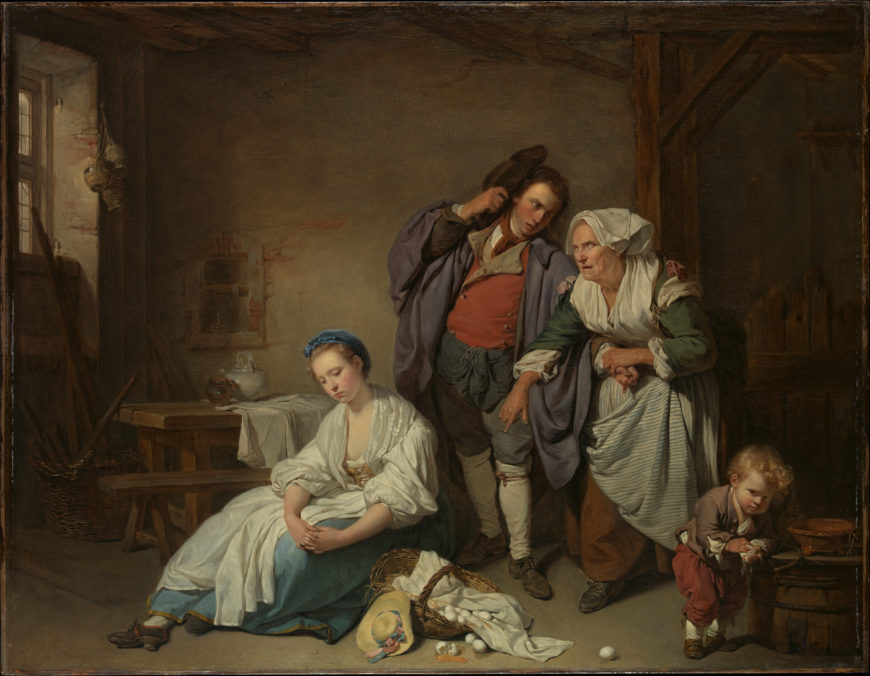
Philipp Otto Runge, The Hülsenbeck Children, 1805–06, oil on canvas, 131.5 x 143.5 cm (Hamburger Kunsthalle)
Runge and Romanticism
Illuminated by the warm light of a midday sun, three young children are pictured playing outside their family home in the Hamburg borough of Eimsbüttel (in what is today Germany) one summer afternoon. With rosy cheeks and sun-drenched hair, these three pudgy children exude the youthful glow of summertime.
Although he is not well remembered today, the artist, Philipp Otto Runge, played a vital role in the early development of Romanticism—a term now used to describe certain trends in the arts, literature, and philosophy around the turn of the nineteenth century. In art, as in literature, Romanticism often stressed depth of feeling, self-reflection, personal authenticity, and the near infinite potential of imagination. We witness such interests at play in Runge’s portrayal of the Hülsenbeck children. With their dramatic poses and the solemn intensity of their stares, these children are presented in a fashion characteristic of the period. Above all, Runge’s portrait exhibits a uniquely Romantic captivation with the subject of childhood.
The stages of childhood
This portrait was commissioned for Friedrich August Hülsenbeck, a German shipping merchant and business partner of the artist’s older brother, and depicts Hülsenbeck’s three children, Maria, August, and Friedrich. As one of the best-known child portraits of the early nineteenth century, it typifies the Romantic fascination with youth and human origins.
Runge arranged the figures according to age and height, with three distinct stages of childhood development allegorically presented in a temporal sequence progressing from left to right.
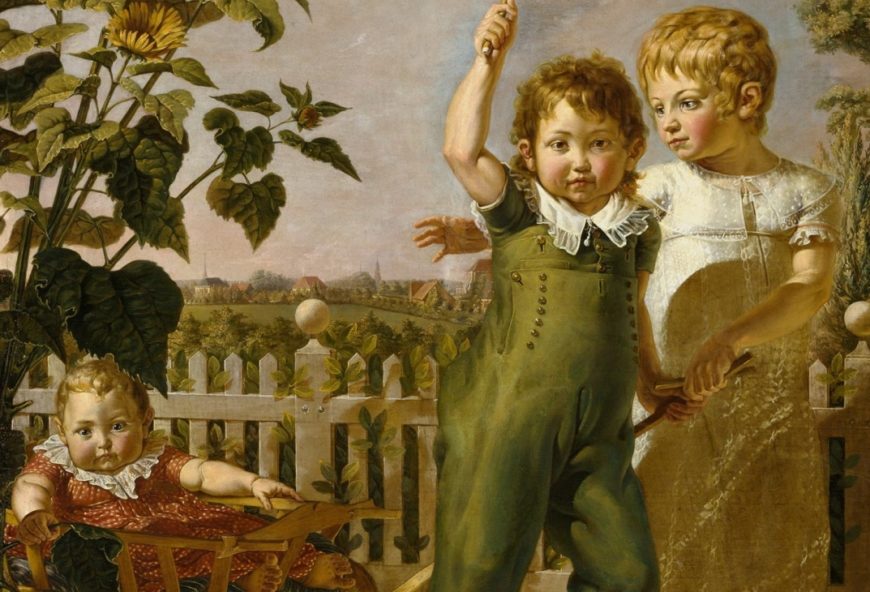
Detail, Philipp Otto Runge, The Hülsenbeck Children, 1805–06 (Hamburger Kunsthalle)
On the left, seated in his carriage, the cherubic Friedrich gazes placidly out at viewers from underneath a towering sunflower plant that frames the left side of the canvas. To Friedrich’s right, the two eldest children, August and Maria, stand posed mid-stride as they pull their infant brother along a narrow garden path. Equally pudgy and slightly darker-haired than his younger brother, August strides to the right brandishing a riding crop triumphantly above his head, as if in the midst of some role-playing children’s game. To his left is the eldest and tallest child, Maria. The only figure not to regard us head-on, Maria turns rearward and reaches for her youngest brother. With this protective gesture, she assumes a motherly ethos and carries out her charge as eldest child.
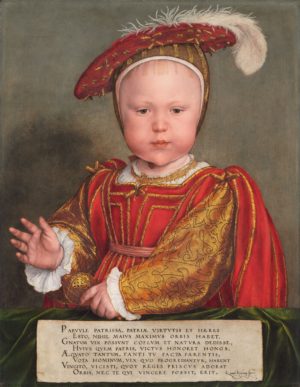
Hans Holbein the Younger, Edward VI as a Child, c. 1538, 56.8 x 44 cm (The National Gallery of Art, Washington, D.C.)
A new kind of portrait and a new idea of childhood
Runge’s painting departs from earlier paradigms of child portraiture, such as those which treat children as miniature adults (for example, Hans Holbein’s Edward VI as a Child) or as dramatic types in moralizing stories (for example, Jean-Baptiste Greuze’s Broken Eggs). His painting helped to usher in a new era in the representation of children focused on individual selfhood, interiority, and youthful innocence. As such, it reflects the changing conceptions of the period.
Beginning in the mid-eighteenth century, childhood began to be viewed with greater interest and respect, as a unique stage of human development. Fundamental to this conceptual shift was the idea that children are not by nature fallen sinners but innocent and intrinsically good.
The 18th-century French philosopher Jean-Jacques Rousseau, whose work would have a significant influence on German thought, was instrumental in the promotion of this new view. In his 1762 educational treatise, Émile, Rousseau advocated a novel approach to education that emphasized children’s free and natural development. Rejecting methods of rote memorization and harsh discipline, Rousseau conceived of learning as an organic process by which an individual grows into a more authentic and perfect version of himself. The teacher’s task is to help guide the student’s self-realization without undermining his or her individual agency.
Rousseau’s ideas would have a significant impact on his German contemporaries (including Johann Gottfried Herder and Wilhelm von Humboldt), who would integrate similar views into their theories of Bildung. Roughly translatable as “self-formation,” the German term Bildung would become vital for the dawning Romantic movement and the new literary genre of the Bildungsroman, or “novel of self-formation.” These were coming-of-age stories that chronicled an individual’s process of self-realization over time.
Runge’s painting of the Hülsenbeck children presents viewers with an image of childhood largely consistent with these shifting views and can be seen as an attempt to create the visual equivalent of the Bildungsroman. Rather than picture Friedrich, August, and Maria as imitating the behavior of adults (such as Holbein had in Edward VI), Runge presents them as authentic children in their natural habitat: an environment scaled to the perspective of a child’s eyes.
Outdoors and surrounded by blooming vegetation, the children inhabit a verdant domain akin to the state of nature that both Rousseau and Herder had identified with youth. Human development is seen as analogous to the organic growth of the vegetable world, and childhood itself is likened to the naturalness of plant life. Although children are presented here as spontaneous and innocent, they are also integrated into a world made and shaped by human craft, not unlike the overgrown vines that wind between the pickets of the Hülsenbeck garden fence. Throughout the painting, we note a synergy between nature and various signs of human design: the urban landscape in the distance; the three children’s carefully tailored clothes; and the surrounding architecture (including a fence marking lines of property).
A low perspective
Perhaps most striking is Runge’s manipulation of scale. The white picket fence, red-roofed cottages, and narrow garden path are all scaled to the size of the three children’s bodies—as is the canvas which they fill. With this unusual treatment of relative size alongside the use of low-angle perspective, Runge presents these children as the nexus of their world, around which everything else is oriented (including viewers). Looking up at Friedrich, August, and Maria in their natural habitat, we are offered a portrait of turn-of-the-nineteenth-century suburban life pictured from a child’s point of view.
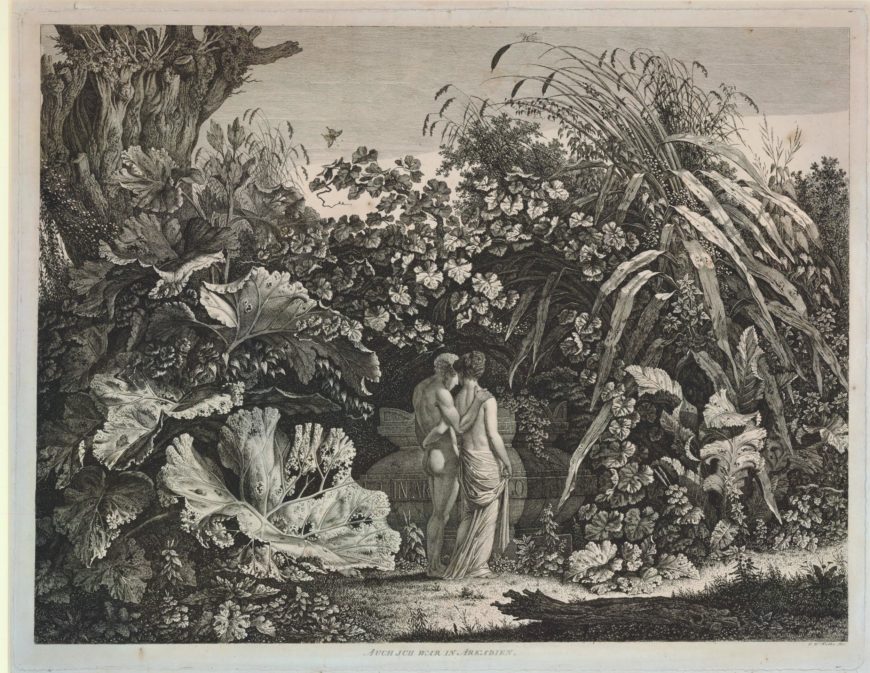
Carl Wilhelm Kolbe, Auch ich war in Arkadien (I too was in Arcadia), 1801, etching, 54.2 x 41 cm (The British Museum)
The painting’s dislocations of scale and dramatic presentation of plant life were likely inspired by the eccentric prints of the contemporary German artist, Carl Wilhelm Kolbe. Primarily an etcher, Kolbe was known for his exaggerated and anthropomorphic portrayals of vegetation, such as we see in his I too was in Arcadia. In The Hülsenbeck Children, Runge, like Kolbe, selectively magnifies detail and animates plant life with an almost uncanny vitality, generating an unsettling tension between figure and environment. The ultimate effect is that we, as beholders, not only assume a child’s point of view but see how a child sees, ascribing special energy and magnitude to certain objects, such as the sunflower, over others.
In this portrait, we also witness the beginnings of Runge’s evolving theory of color, which would reach its culmination with the artist’s unfinished magnum opus, the Times of Day painting cycle, and a theoretical treatise published in February of 1810, just months before his premature death. Unlike in the Times of Day, Runge’s commitment to color in The Hülsenbeck Children is naturalistic rather than primarily symbolic. Bathing the scene in vivid luminosity, the artist generates an authentic sense of summer midday sun in northern Germany. The use of light effects and scintillating radiance that infuses the scene may even be seen to foreshadow Impressionist painting of the later nineteenth century (an impressive accomplishment given that the work was produced during winter).
Although Runge’s theory of color would largely be overshadowed by that of his contemporary Johann Wolfgang von Goethe, it regained interest in the early twentieth century, inspiring, among others, Bauhaus teachers such as Paul Klee and Wassily Kandinsky.
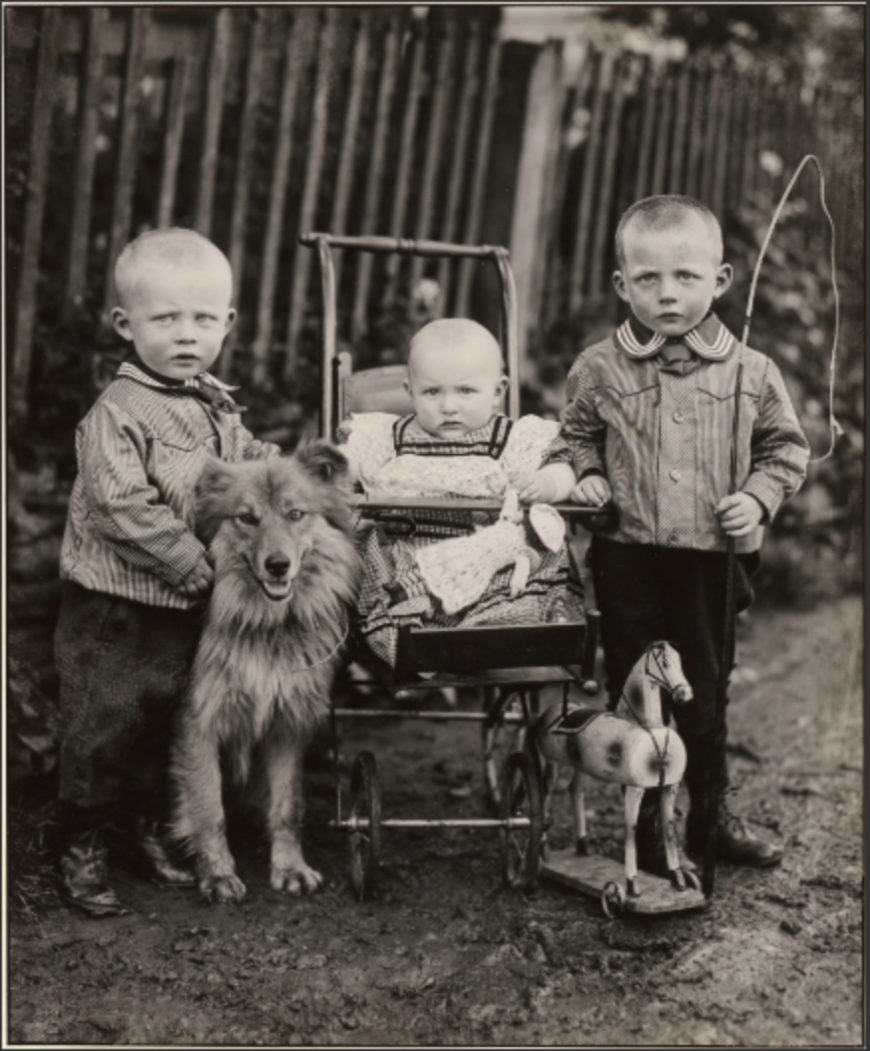
August Sander, Farm Children, Westerwald, 1913, gelatine silver print, 27.6 × 22.7 cm (J. Paul Getty Museum)
The painting’s impact
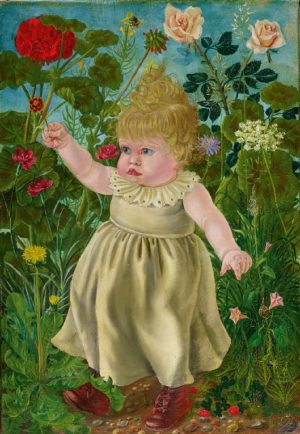
Otto Dix, Nelly among Flowers, 1924, oil on canvas, 81 x 55.5 cm (Museum Folkwang, Essen)
During the early twentieth century, artists from Otto Dix (for example his Nelly Among Flowers) to August Sander (see his 1923 photograph Peasant Children, Westerwald) would likewise find in Runge’s portraits, an image of childhood fit to be variously reimagined for a modern audience. During roughly the same period, and in a more dystopic segment of history, Runge’s pictures—along with those of Caspar David Friedrich—would also be maliciously misappropriated by National Socialism as a symbolic image of German purity and of the rootedness of national culture in local climate and soil.

